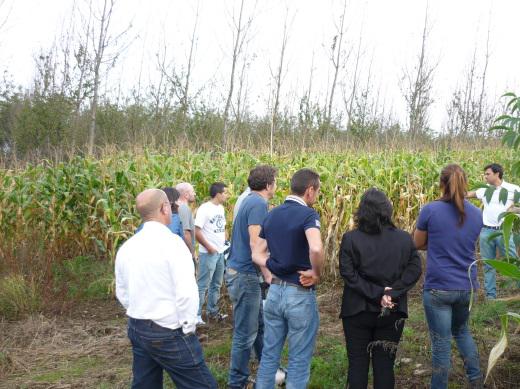
Δασογεωργικά συστήματα στην Ισπανία
Περιγραφή του συστήματος
Στην Ισπανία, η εταιρεία "BosquesNaturales" διεξάγει δασογεωργικά πειράματα με κλώνους καρυδιάς (Juglansspp.) και αραβόσιτου (Zeamays).
Αρχική συνάντηση ενδιαφερόμενων φορέων
Μια πρώτη συνάντηση των ενδιαφερόμενων φορέων, με 14 συμμετέχοντες, πραγματοποιήθηκε στη Γαλικία, στις 21 Οκτωβρίου 2014. Ως θετικές απόψεις του δασογεωργικού συστήματος θεωρήθηκαν οι επιχειρηματικές ευκαιρίες, η πρωτοτυπία και το ενδιαφέρον, η επιτευξιμότητα του έργου, η ποικιλία των παραγόμενων προϊόντων και τα γενικά περιβαλλοντικά οφέλη. Οι αρνητικές απόψεις περιέλαβαν την πολυπλοκότητα του συστήματος, το κόστος εργασίας και διαχείρισης και τις απώλειες που οφείλονται στα άγρια ζώα. Η ενσωμάτωση δένδρων, αραβοσίτου και φαρμακευτικών φυτών και ζητήματα προστασίας των δένδρων από τα ζώα αναγνωρίστηκαν ως πιθανές περιοχές για έρευνα.
Το Πανεπιστήμιο της Extremadura στην Ισπανία έχει επίσης ιδρύσει μια ομάδα ενδιαφερομένων φορέων που προσπαθεί να συνδυάσει την παραγωγή σιτηρών με καρυδιές υψηλής αξίας. Η αρχική συνάντηση των ενδιαφερόμενων φορέων περιλαμβάνεται στο 3ο πακέτο εργασίας . Ωστόσο, ορισμένες πτυχές του έργου επικεντρώνονται ιδιαίτερα στις συγκρίσεις μεταξύ των διαφόρων ποικιλιών σιταριού και κριθαριού κάτω από καρυδιές.
Αν επιθυμείτε να μάθετε περισσότερα για τη δραστηριότητα αυτής της ομάδας, παρακαλούμε να επικοινωνήσετε με την DrMaríaRosaMosqueraLosada (mrosa.mosquera.losada@usc.es) or τον DrGerardoMoreno (gmoreno@unex.es).
Κατεβάστε την αρχική έκθεση ενδιαφερόμενων φορέων
Κατεβάστε το αρχικό πρωτόκολλο έρευνας και ανάπτυξης
Ένα ερευνητικό πρωτόκολλο που αναπτύχθηκε από την ομάδα ενδιαφερόμενων φορέων και επικεντρώθηκε στην συγκαλλιέργεια σιτηρών με φυτείες καρυδιάς υψηλής αξίας (που αναφέρθηκαν αρχικά στο 2ο πακέτο εργασίας ) κοντά στο Τολέδο της κεντρικής Ισπανίας ετοιμάστηκε το Μάρτιο του 2015. Ένα ερευνητικό πρωτόκολλο για την συγκαλλιέργεια φαρμακευτικών φυτών και αραβόσιτου με άγρια κερασιά στη Γαλικία ετοιμάστηκε, επίσης, τον Μάρτιο του 2015.
Κατεβάστε την περιγραφή του συστήματος
Μια επικαιροποιημένη έκθεση σχετική με την έρευνα καλλιέργειας σιτηρών κάτω από καρυδιά με σκοπό την παραγωγή ξυλείας υψηλής ποιότητας στην κεντρική Ισπανία ετοιμάστηκε τον Οκτώβριο του 2015. Ανάλογη έκθεση για την συγκαλλιέργεια φαρμακευτικών φυτών και αραβόσιτου με άγριες κερασιές στη Γαλικία ετοιμάστηκε τον Ιανουάριο του 2016.
Lessons learnt
María Guadalupe Arenas-Corraliza, María Lourdes López-Díaz and Gerardo Moreno have completed a lessons learnt report describing the details of a comprehensive set of measurements looking at the interactions between growing walnut trees and wheat and barley crops in Mediterranean Spain.
A shading experiment demonstrated that barley and wheat yields in Mediterranean Spain could be increased with partial or 50% shade, compared to yields in full sunlight. Under some particularly dry and hot years, when the yield of the monoculture barley crop was particularly low, growing the barley within the trees increased barley yields. The effect on barley yields was more positive than that on wheat yields, because the barley crop can complete much of its development before significant leaf growth on the walnut trees. By contrast in cooler and wetter seasons, the highest barley and wheat yields were obtained from the monoculture crop. Measurement of tree growth, also indicated that the cereals reduced tree growth; it is possible that this could be prevented through the use of irrigation. In summary, the results demonstrate that barley yields in particularly dry and hot years can be maintained through the use of tree cover.
Lessons learnt
Rosa Mosquera-Losada and colleagues at the University of Santiago de Compostela have produced two reports. The first describes the responses of maize intercropped between wild cherry trees (Prunus avium L). In an experiment where the trees had been planted in 2008 at interrow spacings of 1.25, 2.5 and 5 m, the total dry biomass produced by intercropped maize (per cropped area) of 4.4 to 14.0 t/ha, was lower than the approximately 25 t/ha of biomass produced in plots without trees due to the spaced occupied by the tree rows. Maize has a “C4” photosynthetic pathway and can respond positively to high light levels. There is a recommendation to test the shade responses of maize varieties to increase production under shade.
The second report focuses on the response of two medicinal crops (Melissa officinalis L. and Mentha x piperita L.) intercropped between wild cherry trees. The yields, although low at 0.3-0.7 t/ha, are similar to those obtained in other studies in open sites. Hence they appear suitable agroforestry crops. The concentration of Rosmarinic acid in the leaves of Melissa officinalis was higher when the crop was grown under a high density, rather than a lower density, of trees. This may be explained because the concentration of Rosamarinic acid is higher before flowering and tree shade delays flowering.